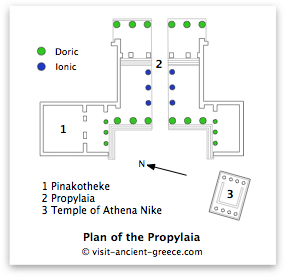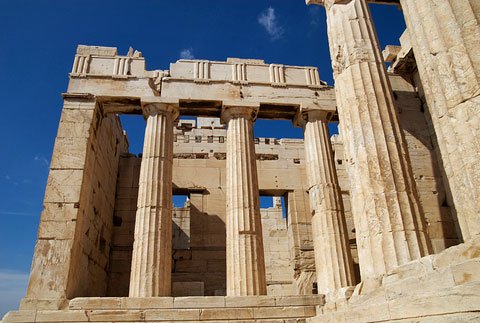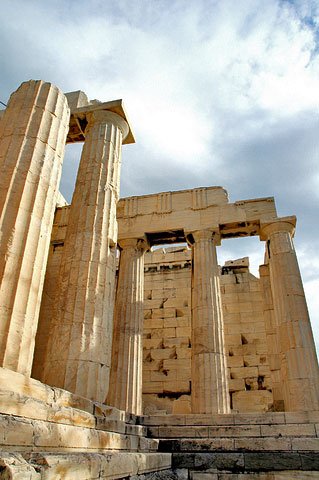The Propylaia (sometimes spelt Propylaea) is the gateway to the temples on the Acropolis. It was built during the years 438 to 432 BC under the guidance of Mnesikles. The word refers to a collection of buildings which form the monumental and impressive structure through which visitors had to pass to reach the main buildings on the site.
First impressions
As you mount the steps to the Propylaia the impression you get is of two large structures with a smaller one in the centre. But this is only because most of the central structure is missing. When it was completed the central ‘gateway’ was the impressive feature, looking like the front of a temple, with three large Doric columns on either side of visitors as they entered.
The stairway you walk up is built into the natural rock. The Propylaia is mainly constructed from Pentelic marble, the same as was used for the Parthenon, and was obtained from nearby Mount Pentelicon.
The Propylaia is impressive as you approach it, but as you enter it and are surrounded by the massive columns and walls, you can really appreciate the effort those ancient builders put into its construction. Even in its ruined state today it still has the power to impress, so how much more it must have made its mark on visitors in ancient times!


A mix of styles
Although the main columns on the front and rear of the structure are of the Doric order, the columns inside the central area are Ionic. As a general rule, the inhabitants of the Greek mainland favoured the more ‘masculine’ Doric style, while the Greeks of the east – those who lived on the islands and the coast of what is now Turkey – preferred the more slender and ‘feminine’ Ionic style.
It has been suggested that by incorporating the Ionic order here and in other buildings, Pericles was trying to show some respect for Athens’ so-called allies during the Peloponnesian war. Whether or not this is correct, Ionic columns were only used inside both the Propylaia and the Parthenon. It was only in the building of the Erechtheion that Ionic columns were used as the main supports.

A secular building
The Propylaia is unique on the Acropolis in that is not dedicated to any deity. It was a purely secular building, to lead visitors up to and onto the Acropolis, and in so doing to ensure they were suitably amazed and impressed.
The north west wing – which is larger than the south west one – was decorated with painted compositions on the walls. These may have been frescoes, or they may have been hanging pictures. Because of these paintings the room was known as the Pinakotheke (picture gallery).
The south west wing is much smaller than the other wing. It only has a single stoa which is enough to provide balance for the whole structure. Also, its size was probably restricted by the position of the sanctuary of Athena Nike which prevented the building expanding to the south, which would have cluttered up that area. There had been a Nike sanctuary in this position from prehistoric times, and the Greeks were always careful not to offend the gods and goddesses.

No ornate treatment
Because the Propylaia was not dedicated to a deity there was no need to go to the trouble and expense of adorning it with sculptures and other decorations. It was a purely functional building, and achieved its purpose in introducing visitors to the Acropolis.
The Pedestal of Agrippa
In case you are wondering what the large and seemingly out of place block of marble is doing right in front of the north wing, it was built in the 2nd century BC. At one time it supported a bronze chariot and horses, and first it included a stature of Eumenes II, king of Pergamon, and later that of Agrippa, son-in-law of the Roman Emperor Augustus.
Many visitors to the Acropolis have made the observation that the approach has been spoiled by this pedestal, and I for one agree with them!